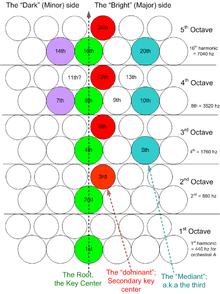Jammer keyboard

A jammer is a new musical instrument characterized by at least one isomorphic keyboard, and thumb-operated and/or motion-sensing expressive controls. The instrument is designed to be fast to learn to play, very fast to play, and very expressive.
Research suggests that the combination of thumb-controls and internal motion sensors could give jammers more expressive potential than other polyphonic musical instruments such as the piano, guitar, and accordion.[1] Isomorphic keyboards similar to those used in a jammer have been shown to accelerate the rate at which students grasp otherwise-abstract concepts in music theory.[2][3]
History
Origin of jammer and Thummer instruments
The jammer was invented by Jim Plamondon in September 2003, whereupon he founded Thumtronics to design its "Thummer(tm)-brand jammer" and bring it to market, the trade name was to emphasize the unique thumb-control feature. Prototype Thummers were produced, but the effort to commercialize them failed, and Thumtronics was disbanded in mid-2009.

Open source jammer
Although not currently under commercial development, an ongoing open source hardware design project seeks to produce a royalty-free reference design for jammers, based on Thumtronics' prototypes.
Do It Yourself (handmade) jammers
Hobbyists are making DIY jammers. Recent availability of adaptable commercial keyboard controllers, especially the Axis-49 from C-Thru Music, has spurred innovation and many functioning jammers have been built. Software for their construction through the modification of commercially available instruments is now available.
Touchscreen based jammers
The many multitouch touchscreen products running Android or iOS, particularly tablet devices, can be adapted to be utilised as jammers. The dynamic display allows for key sizes to be easily adjusted to preference.
Origin and usage of the jammer name
Just as Kleenex(tm) is a trademarked brand of facial tissue, and the Stratocaster(tm) is a trademarked brand of electric guitar, the Thummer was intended to be a trademarked brand of "a new kind of musical instrument." The term jammer was introduced to give that "new kind of musical instrument" a generic, non-trademarked name. It was coined by Jim Plamondon, founder of Thumtronics, and first used when the "Thummer(tm)-brand jammer" was publicly announced on December 15, 2005, in Perth, Western Australia.
Features

- At least one 2-dimensional keyboard in a hexagonal array; preferably, one for each hand. The keys of the left-hand instrument are mirror-imaged to those on the right, to match the mirroring of one's hands. This speeds learning the instrument, as a skill learned in one hand can transfer to the other hand.
- Notes assigned to the array using the ergonomically efficient Wicki-Hayden note layout.[4]
- Preferably one or more thumb-operated expressive control, e.g. the thumb-operated joysticks found on seventh-generation video game controllers, touchpads, or other expressive controls, such as internal motion-sensors (such as those found in the Wii Remote video game controller), foot-pedals, breath controllers, etc.
Advantages over a standard keyboard



| Advantage | Reason |
|---|---|
| Simple to learn | Music intervals are mapped to the same vector: a consistent angle and spacing |
| Easy to play | Only one fingering needs be learned, instead of the 24 (12 for each hand) needed for the standard keyboard |
| Easy to play from a musical score | Playing in a different key is a simple matter of shifting the hand, as shown right. |
| Fast to play | The average distance the fingers need to move is reduced by a factor of 10 or more:
|
| Greater musical intervals can be played by each hand at once | 2 octave range in normal hand position using 4 fingers, 3-4 octaves if the thumb is used |
| More notes can be played | due to the ability to play several consonant notes at once, with a single finger |
| Examples | * 9th, 10th 12th and 15th chords can be played easily with the hand in normal position
|
| Multiple concordant notes can be played with one finger | consonant notes are placed adjacent to each other |
| Variety of novel glissandos | Glissandos of fourths, fifths and major seconds are easily played |
| Separate expressiveness controls for each hand | Allows twice the choice of expressive options, e.g. Sustain pedal |
| Capable of more sounds than a traditional keyboard | With two keyboards, each can be assigned to a separate instrument |
| Controls provide more means of expression than a traditional keyboard instrument, so in principle can offer greater expressiveness | |
| Places notes in a pattern that matches the natural harmonics, as shown right. | |
| Separate keys for flat and sharp notes | This unique feature allows more accurate, just tuning of the notes of the keyboard, as well as a host of tuning options This feature is seen in Florentine harpsichords and some 16th century organs designed to accompany singers. |
| Lightweight and portable | Smaller and lighter than a guitar |
Limitations and disadvantages over a standard keyboard
- The distance between chromatic intervals is greater
- Not all chord inversions are easy to finger
- Chromatic scales take longer to learn, although they are easy to play
- Harder to learn than the piano in C major
- No teachers or body of pedagogy for the jammer
- Fingering techniques are still being developed
- No formal theory of play has been developed, although one is under development, and related to standard jazz "jamming" techniques.
- High cost of hexagonal keyboards relative to the standard keyboard (given current sales volumes)
Differences from the Thummer design ideal
Jammers are forced to make do with an assembly of independent parts. The Thummer design patents are useful as a design goal, because of its many novel features.
| Thummer | Jammer |
|---|---|
| Wider keyboard, with 19 notes per octave, 9.5 keys wide, in a curved, 6 row arc. | Whatever the adapted instrument allows, typically 7 rows wide, 14 high . |
| Additional expressiveness by means of motion sensing, thumb operated joysticks, velocity sensitivity, and after-touch. | Thumb-controls, mounted on the hand or jammer, or motion-sensing Wii-sticks, and velocity sensitivity. |
| A brace through which one can affix the instrument to ones forearm and take advantage of the motion sensing capability. | No brace. the instrument instead is table or chest-mounted. |
| Keys shaped and spaced to allow the maximum number of keys to be reached at once. | Keys in a purely hexagonal array, with an almost-touching spacing. |
How jammers are being made

- The computer qwerty keyboard is a nearly hexagonal array of keys, so can be mapped into Wicki/Hayden layout through software applications such as the Transformsynth and Bomes midi translator (link). However limitations of the qwerty keyboard limit this usefulness.
- There are commercially available isomorphic instruments with an applicable hexagonal array of keys. Commercially available keyboard instruments that do not use the Wicki/Hayden note layout but use USB midi are modified via re-mapping software for the Axis-49.
- In the past, experimental keyboards have been made by hand, as shown right.
- Alternate input devices such as the Korg Nano series are most often used to give a jammer player more expressive potential. Game console joysticks have been found to offer excellent expression. Experimentally, a hand-mounted, thumb operated control has been found to be superior, as it allows full mobility to the hand.
- After-touch has not been explored for jammers. Motion sensing has yet to be explored by jammer players because of its lack of accessibility and/or applicability to expressive control in its current forms.
- Adding an arm brace to the jammers has yet to be explored, due to the lack of feasible motion sensing capabilities.
Design Rationale
Of the large number of isomorphic note assignments possible, jammers use the Wicki-Hayden note layout. All scales fall in the center of the layout, directly under ones fingers, and it is simple to relate to conventional music notation. All conventional chord progressions can be easily fingered in the jammer arrangement with minimal hand movement.
Octaves ascend vertically, increasing the playable interval sizes, easing chord inversions, and greatly reducing the time needed to move to a new note or chord.
Ergonomic Factors
Although no one is yet expert on a jammer, Fitts law predicts that the jammer will be very significantly faster to play that a conventional keyboard. The expected speed increase is (log base 2 (30% smaller key / ~1000% distance decrease) or 75% less time to find and press the average key. Since playing an instrument is always a speed vs accuracy tradeoff, a novice player should be able to play more accurately, while a trained player should be able to play with more precise timing.
Commercially available
Some hexagonal isomorphic keyboards are commercially available:
- AXIS-64, uses the Harmonic Table note-layout
- Opal Chameleon, uses the Melodic Table note-layout
- Stagi Hayden Duet Concertina, uses the Wicki note-layout, shown in Figure 1 above (known as the 'Hayden' layout by concertina players)
- Mobile applications: iJammer and Musix convert iOS devices into concertinas and jammers. For Android, there are IsoKeys and the opensource Hexiano.
Devices that do not use the wicki-hayden note layout natively can be converted to jammers by electronically remapping the notes received via USB midi to the wicki-hayden note layout.
Software
- Wicki.org.uk, free UK site containing Java, Flash, and PC applications to enable users to play their alpha-numeric keyboard to sound 12 equal tempered pitches using Wicki/Hayden or Jankó keyboard layout.
- Musix provides a Jammer among other isomorphic layouts to iPad users.
- On Android, there is the free IsoKeys and the opensource Hexiano.
- Dynamictonality.com provides free Dynamic Tonality synthesizers, the TransformSynth and 2032, as well as a realtime tonality mapper which maps the QWERTY keyboard to the wicki-hayden note layout and allow for the dynamic change in both tuning and timbre along a smooth continuum.
See also
- Information on the Thummer
- Jim Plamondon: inventor of the jammer
- The Wicki-Hayden note-layout explained
- The Melodic/Harmonic table note-layout explained
- Isomorphic keyboards
- The Generalized keyboard
- AltKeyboards.com, dedicated to the development of new musical instruments
References
- ↑ Paine, G.; Stevenson, I.; Pearce, A. (2007). "The Thummer Mapping Project (ThuMP)". Proceedings of the 7th international conference on New Interfaces for Musical Expression (NIME07): 70–77.
- ↑ Holland, S. (1993). "Learning about harmony with Harmony Space: An overview". Proceedings of the 1993 World Conference on Artificial Intelligence in Education on Music Education (AI-ED 93): 24–40.
- ↑ Bergstrom, T.; Karahalios, K.; Hart, J. C. (2007). "Isochords: visualizing structure in music". Proceedings of Graphics Interface 2007.
- ↑ Milne, Andrew; Sethares, W.A.; Plamondon, J. (March 2008). "Tuning Continua and Keyboard Layouts". Journal of Mathematics and Music 2 (1): 1–19. doi:10.1080/17459730701828677. Retrieved 2009-09-20.
| ||||||||||||||||||||||||||||||||||||||
